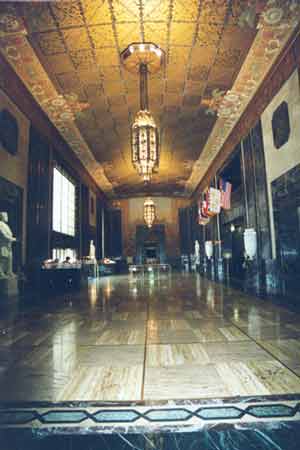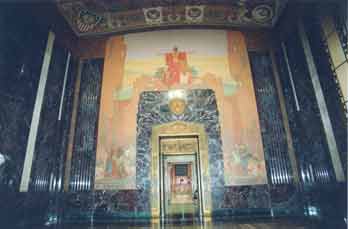Louisiana Capitol History and tour

A view of Memorial Hall from the House Chamber, looking toward the Senate Chamber.

MEMORIAL HALL
Memorial Hall, sometimes erroneously referred to as the
"rotunda," measures 35 by 120 feet and is two stories high. The floor is made of
Mt. Vesuvius lava from Italy. In the center of Memorial Hall is a 3,290 pound bronze
relief map of Louisiana. The map lists each of the 64 parishes (counties) in the state
around its border and depicts symbols of Louisiana’s major industries and natural
products.
Solid bronze elevator doors on the north side of Memorial Hall feature
reliefs of Louisiana’s American governors, starting with the first, W.C.C. Claiborne
on the top left and ending with Gov. Huey P. Long on the top right. The walls surrounding
the elevator are made of dark red Lavanto marble from Italy.
Above the elevators hang each flag that has flown over Louisiana. The
flags are:
1: Castille and Leon - Spanish
2: Fleur-de-Lis - French
3: Union Jack - British
4: Bourbon Spain - Spanish
5: French Tri-Color
6: Fifteen star United State Flag
7: Lone Star - West Florida Republic
8: National Flag of Louisiana
9: Louisiana State Flag
10: United States Flag
The vases on either side of the elevators were a gift from France in
1934, a token of friendship. They are Sevres porcelain and the bases are solid gold. Two
solid bronze chandeliers, weighing two tons each, are anchored on the 5th floor.
There are four white Georgia marble statues in Memorial Hall. To the
right of the main entrance, is Gov. Francis T. Nicholls, a Confederate general during the
Civil War who served as governor twice after the war. Across Memorial Hall, is W.C.C.
Claiborne, the governor of Louisiana who served after its purchase from France in 1803. He
was also governor when Louisiana gained statehood in 1812. On the other side of the Hall,
near the Senate Chamber is Jean Baptiste LeMoyne Sieur de Bienville, who founded New
Orleans in 1718. Lastly, nearest the Baton Rouge tourist desk, is Gov. Henry Watkins
Allen, governor during the Civil War. On the wall near the Senate chamber, next to the
statue of Gov. Allen, is a bust of P.B.S. Pinchback, Louisiana’s first and only black
governor.
The side walls of Memorial Hall are graced with murals painted by Jules Guerin, a noted American muralist and illustrator from St. Louis, MO.
The mural on the east wall is referred to as the "Goddess of
Knowledge and Time." The central figure holds a zodiac in one hand and an hourglass
in the other. Harvest scenes make up the background. On the west wall, the mural is
referred to as "Abundance of the Earth." The central figure here represents
agriculture and the figures surrounding her represent art, literature and music. Both
murals depict Louisiana as a land of plenty.
As you face the elevators, looking north, the House of Representatives
Chamber is on the far right (east,) the Senate Chamber is on the far left (west.)